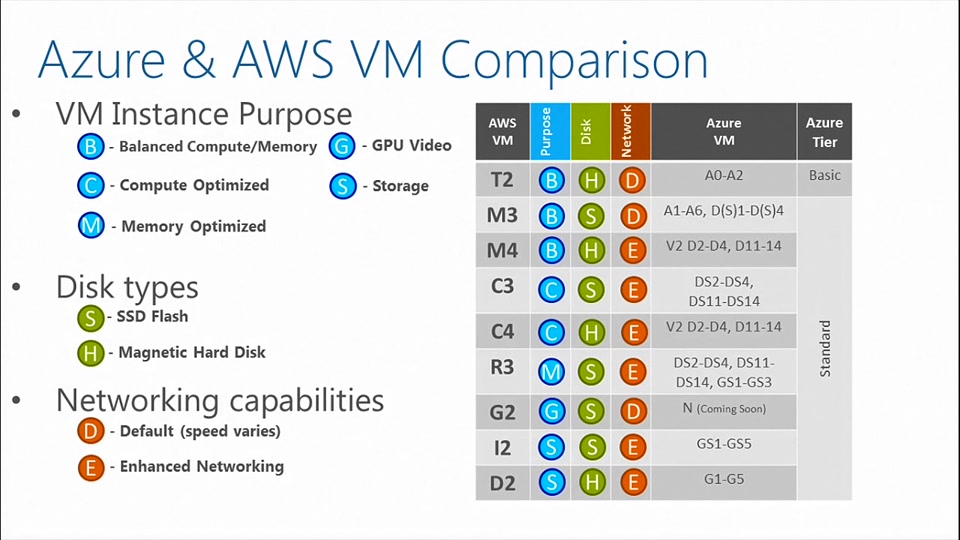https://channel9.msdn.com/Shows/TechNet+Radio/TNR1670
Return to Main Menu
VM Series Descriptions
- A Series
- Highest value vm sizes
- Basic and standard sizes
- General Purpose and High Memory
- DNS, FTP
- High Performance (A8/A9) (RDMA Networking)
- D Family
- 60% Faster CPU
- Up to 112GB Memory
- Local SSD storage (non-persistent)
- G Series
- Optimized for data workloads
- Up to 32 CPU cores, 448GB RAM, 6.5TB local SSD (non-persistent)
- Latest Gen Intel Processor
- GS / DS
- Allow Persistent SSD storage (Premium Storage): https://docs.microsoft.com/en-us/azure/virtual-machines/windows/premium-storage
- This is akin to Provisioned IOPs
- Allow Persistent SSD storage (Premium Storage): https://docs.microsoft.com/en-us/azure/virtual-machines/windows/premium-storage
Sizing Recommendations
- Find out what the client is currently using
- When in doubt, start small and work your way up.
AWS vs Azure Instance Comparisons
Availability Sets vs Availability Zone
- Availability Set
- Different ‘Fault Domain’
- Maintenance, hardware, etc.
- VMs automatically deployed into different Fault Domains to improve overall uptime
- Uptime SLA 99.95 based on min. 2 VMs in an Availability Set. (lame…)
- Different ‘Fault Domain’
- Availability Zone
- Different building / datacenter
- Require unique subnets
Anatomy of an Iaas v2 Deployment
Lab: Creating an Azure Virtual Machine
- Dashboard > Virtual Machines > [Create a virtual machine] > Select Image
- Select Deployment Model: Resource Manager
- [Create]
- Basics
- Name: VM Name, not your name 🙂
- Username
- Authentication
- Password or
- SSH public key (paste in)
- ssh-rsa AAAAB3NzaC1yc…llT59o1ixbrt
Building VMs from the CLI
Basic Commands
Switch Display modes
Azure Resource Manager
azure config mode arm
Azure Service Manager (Classic Mode)
azure config mode asm
Show current subscription
azure account show
Change Account
azure account set SubscriptionName
VM Help
azure vm --help
Show VMs
azure vm list
Create a VM
azure vm create --resource-group test --location centralus --os-type linux --image-urn UbuntuLTS --admin-username ubuntu --admin-password @asdDSA123$ --vm-size Standard_B1S --nic-name MyNic --name thomas-server-02 --public-ip-name mypublicip --public-ip-domain-name thomas-public-ip --vnet-name thomas-01 --vnet-subnet-name default
Helpful Hints
azure vm create --help
Show standard images aliases
azure vm image --help
Commands to manage VM images Lists virtual machines image publishers vm image list-publishers [options]Lists virtual machines image offers by a publisher vm image list-offers [options] Lists virtual machines image skus for a specific offer from a publisher vm image list-skus [options] Lists the virtual machines images vm image list [options] [offer] [sku] Lists the virtual machines images vm image show [options] Options: -h, --help output usage information Current Mode: arm (Azure Resource Management) Consider Azure CLI 2.0, the preferred choice for ARM - https://aka.ms/move2cli2
Win2012R2Datacenter = MicrosoftWindowsServer:WindowsServer:2012-R2-Datacenter:latest Win2012Datacenter = MicrosoftWindowsServer:WindowsServer:2012-Datacenter:latest Win2008R2SP1 = MicrosoftWindowsServer:WindowsServer:2008-R2-SP1:latest CentOS = OpenLogic:CentOS:7.2:latest CoreOS = CoreOS:CoreOS:Stable:latest Debian = credativ:Debian:8:latest openSUSE = SUSE:openSUSE:13.2:latest RHEL = RedHat:RHEL:7.2:latest SLES = SUSE:SLES:12-SP1:latest UbuntuLTS = Canonical:UbuntuServer:14.04.4-LTS:latest
Cleaner with json
azure vm image list-skus --location centralus --publisher Canonical --offer UbuntuServer --json
Get VM Sizes
azure vm sizes --location centralus
List Locations
azure location list

